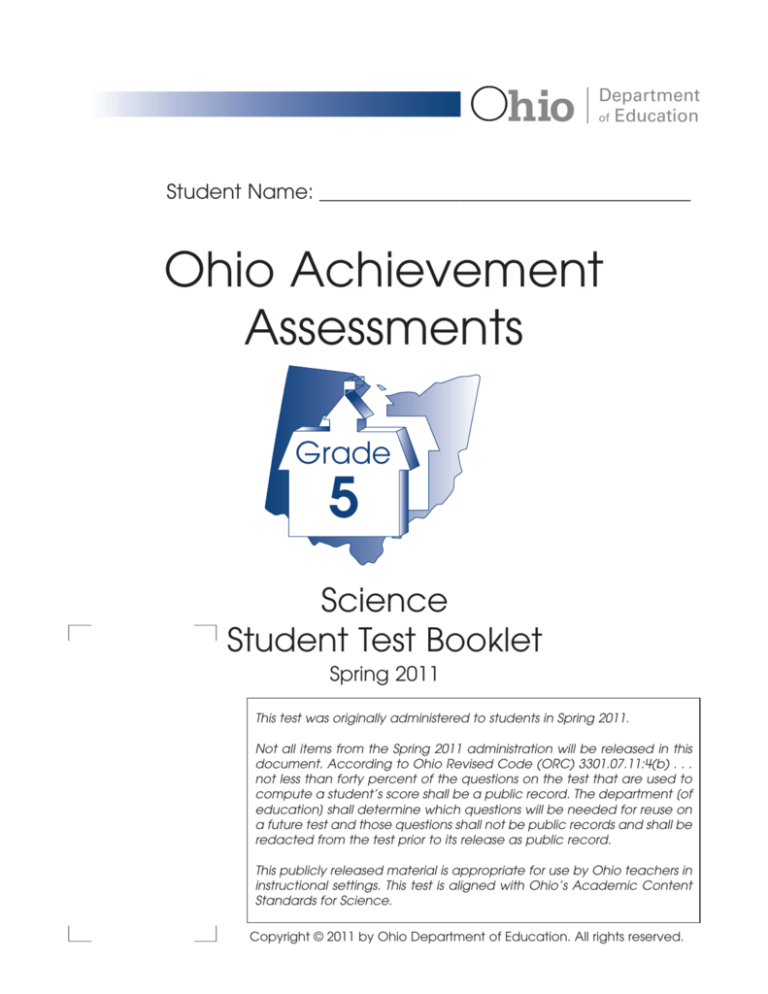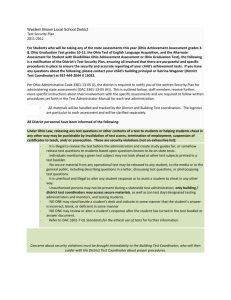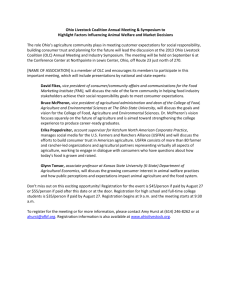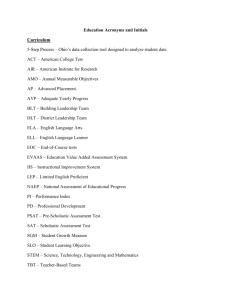
hio
Department
of Education
Student Name: _____________________________________
Ohio Achievement
Assessments
Grade
5
Science
Student Test Booklet
Spring 2011
This test was originally administered to students in Spring 2011.
Not all items from the Spring 2011 administration will be released in this
document. According to Ohio Revised Code (ORC) 3301.07.11:4(b) . . .
not less than forty percent of the questions on the test that are used to
compute a student’s score shall be a public record. The department [of
education] shall determine which questions will be needed for reuse on
a future test and those questions shall not be public records and shall be
redacted from the test prior to its release as public record.
This publicly released material is appropriate for use by Ohio teachers in
instructional settings. This test is aligned with Ohio’s Academic Content
Standards for Science.
Copyright © 2011 by Ohio Department of Education. All rights reserved.
The Ohio Department of Education does not discriminate on the basis of race, color, national
origin, sex, religion, age, or disability in employment or the provision of services.
The Ohio Department of Education acknowledges that copyrighted material may contain
information that is not currently accurate and assumes no responsibility for material
reproduced in this document that reflects such inaccuracies.
Science
Directions:
S
Today you will be taking the Ohio Grade 5 Science Achievement Assessment.
Three different types of questions appear on this test: multiple choice, short
answer and extended response.
There are several important things to remember:
1.
Read each question carefully. Think about what is being asked.
Look carefully at graphs or diagrams because they will help you
understand the question. Then, choose or write the answer you think
is best.
2.
Use only a #2 pencil to answer questions on this test.
3.
For multiple-choice questions, fill in the circle next to your answer choice.
Mark only one answer for each question. If you change your answer,
make sure you erase your old answer completely. Do not cross out or
make any marks on the other choices.
4.
For constructed-response questions, write your answer neatly, clearly
and only in the space provided in your Answer Document. Any
responses written in your Student Test Booklet will not be scored.
5.
Short-answer questions are worth two points. Extended-response
questions are worth four points. Point values are printed near each
question in your Student Test Booklet. The amount of space provided
for your answers is the same for all two- and four-point questions.
6.
If you do not know the answer to a question, skip it and go on to
the next question. If you have time, go back to the questions you
skipped and try to answer them before turning in your Student
Test Booklet and Answer Document.
7.
Check over your work when you are finished.
8.
When you finish this section of the test, you may NOT go back to the
reading or mathematics sections in the Student Test Booklet.
75
S
Science
Items 1– 3 have not been slated for public release
in 2011.
76
Go to the next page
S
Science
Use the following picture to answer question 4.
4. Soybean Plant
Flower
Leaf
Stem
Roots
What structure on this plant makes seeds so that the plant can reproduce?
A. leaf
B.
root
C. stem
D. flower
16117; 5S0000LSBXR0880D
FT Form I SP07 (17)
Item 5 has not been slated for public release in 2011.
78
Go to the next page
S
Science
6. Two students perform an investigation to test the effects of sugar water on
plant growth. The observations of both students are shown in the table.
Plant Growth Observations
Student 1
Student 2
Plain Water Sugar Water Plain Water Sugar Water
Final Height of Plant
Very Tall
Short
15 cm
10 cm
Number of Leaves
More
Less
18
7
Number of Flowers
A Lot
A Few
3
1
Both students conclude that the plant given plain water is healthier than
the plant given sugar water.
In your Answer Document, explain why Student 2’s conclusion is more
scientific than Student 1’s conclusion. Support your response with evidence
from the investigation. (2 points)
19232; 5S0000SKCXC2063S
FT Form I SP09 (16)
Items 7– 8 have not been slated for public release
in 2011.
On the Spring 2011 Grade 5 Science Achievement
Assessment, items 9 –14 are field-test items, which
are not released.
80
Go to the next page
S
Science
Use the information below to answer question 15.
Property of Four Substances
at Room Temperature
Property
Substance
W
State of Matter
X
Y
Z
Gas Solid Liquid Solid
Takes the Shape
of Its Container
Yes
No
Yes
No
Conducts Electricity
No
Yes
No
No
Can Be Stretched
Into Thin Wires
No
Yes
No
No
15. According to this information, which substance is a metal?
A. substance W
B.
substance X
C. substance Y
D. substance Z
17099; 5S0000PSBXC1638B
FT Form G SP08 (12)
Item 16 has not been slated for public release in 2011.
88
Go to the next page
S
Science
Use the following information and picture of a beetle to answer question 17.
17. A student is sitting at a desk. A beetle lands on the desk.
1 cm
The use of which tool allows the student to easily observe the beetle’s legs
as it is walking across the desk?
A.
B.
Binoculars
Telescope
C.
D.
Magnifying Glass
Light Microscope
14430; 5S0000SIAXD0669C
Form D SP07 (18)
Item 18 has not been slated for public release in 2011.
90
Go to the next page
S
Science
19. The sun is a star of average size and brightness. From Earth, the sun appears
as a round, yellow object in the daytime sky. At night, we see other stars.
They appear as tiny points of light.
Why does the sun appear larger than stars that we see at night?
A. Daylight brightens the sun, making it appear larger.
B.
Starlight bends as it passes planets, making the stars appear smaller.
C. The sun is closer to Earth than other stars, making the sun appear larger.
D. Earth’s atmosphere filters out light from other stars, making them
appear smaller.
14603; 5S0000ESAXR1668C
FT Form A SP08 (7)
92
Go to the next page
Science
S
20. A student stands outside on a cold winter day. His hands become cold and
he rubs them together to make them warmer.
Which statement explains why rubbing his hands together makes
them warmer?
A. This action produces thermal energy through friction.
B.
This action conducts thermal energy away from the body.
C. This action captures thermal energy from the environment.
D. This action reduces the amount of thermal energy transferred to the air.
19221; 5S0000PSDXR2054A
FT Form G SP09 (17)
93
Go to the next page
S
Science
Use the following information to answer question 21.
Some cups are better than others for serving hot liquids. Characteristics of
these cups include the following:
•
•
•
Safety: reduces the risk of spilling hot liquid due to the cup bending,
cracking, leaking, or falling over
Insulation: slows the transfer of thermal energy to help keep the liquid at
the same temperature
Reusable/Recyclable: can be reused after washing or can be recycled
The table below shows characteristics of five different cups. All cups will
hold 150 mL. The same amount of hot cocoa at 70ºC is put in each cup.
Properties of Five Cups
Cup
Material
Aluminum
Metal
Clear
Glass
Coated
Paper
Glazed
Clay
Plastic
Foam
Is the
Material
Sturdy?
Does Not
Bend or
Break
Does Not
Bend but
Can
Crack or
Break
Easily
Bends or
Tears
Does Not
Bend but
Can
Crack or
Break
Could
Bend,
Can Crack
or Break
Can a
Cup Be
How Heavy Is
a Cup?
Reused or
Recycled?
What Is the Final
Temperature of
Hot Cocoa After
15 Minutes?
50 grams
Yes
Yes
27°C
180 grams
Yes
Yes
29°C
5 grams
No
No
35°C
350 grams
Yes
No
37°C
5 grams
No
Yes
39°C
94
Go to the next page
Science
S
21. Choose two of the materials from the table. In your Answer Document,
describe one advantage and one disadvantage of using each of these
two materials for cups used to serve hot cocoa. (4 points)
14868; 5S0000STAXA0575E
FT Form C SP07 (21)
Items 22–26 have not been slated for public release
in 2011.
95
Go to the next page
S
Science
27. Students plan to observe the effects of mixing liquids with flour, baking soda,
baking powder, and salt. A liquid dropper helps students control the
amount of water or vinegar used. Students must mix one of these liquids
with the contents of each container.
Flour
Baking
Soda
Baking
Powder
Salt
Vinegar
Investigation With Vinegar
Water
Investigation With Water
In your Answer Document, describe one possible safety hazard in
this investigation.
Then describe one way to make sure that this investigation is safe from
this hazard. (2 points)
14624; 5S0000SICXD0530S
FT Form E SP06 (27)
100
Go to the next page
Science
28. An electric circuit is shown.
S
Electric Circuit
Battery
Light Bulb
Wire
N
W
E
S
Compass
Why does the compass needle move when the compass is placed near
the wire?
A. because electric current makes the light bulb give off thermal energy
B.
because electric current produces magnetic forces
C. because of the plastic coating on the wires
D. because of the light of the bulb
17671; 5S0000PSEXR1714B
FT Form E SP09 (13)
101
Go to the next page
S
Science
29. The weather systems shown below will move by September 16.
Weather in Ohio at Noon on September 15
Cleveland
Van Wert
Wert
Van
N
W
Columbus
E
S
Marietta
Key
Warm Front
Cold Front
80s
70s
60s
Based on the weather map, which city will be next to experience
cooler temperatures?
A. Van Wert
B.
Cleveland
C. Columbus
D. Marietta
14663; 5S0000ESDXC1212B
FT Form E SP08 (8)
102
Go to the next page
Science
S
Items 30–32 have not been slated for public release
in 2011.
33. Which explains the pattern of day and night?
A. Earth orbits the sun.
B.
Earth spins on its axis.
C. The sun only transmits light energy during the daytime.
D. The sun only transmits light energy above the equator.
14020; 5S0000ESAXR0409B
FT Form D SP06 (39)
105
Go to the next page
S
Science
Use the following information to answer questions 34–37.
Investigating Plant Growth
Students in a class predict that if they double the amount of water given to
tomatoes then the plants will grow twice as tall. The class plants a seed in each
planter shown.
Window
Planter
Group A
Group B
Planters in Group A receive 5 mL of water each day. Planters in Group B receive
10 mL of water each day.
The class measures the heights of the plants every Friday. The average height for
each group is recorded in the table shown.
Average Height
Week
Group A
(cm)
Group B
(cm)
1
2
3
4
5
0.5
2.0
3.0
4.0
4.5
0.5
2.0
3.5
5.5
7.5
964; 5S0123LSXXX0000X
106
Go to the next page
Science
34. Students continue to record data on plant height.
S
Why is it important to record data every Friday?
A. to check for diseases on the plants
B.
to see whether the data are correct
C. to see whether plants grow more on Fridays
D. to have the same time span between measures
13619; 5S0123SKCXD0002D
FT Form A SP06 (24)
35. Why did the plants in group B grow taller than the plants in group A?
A. Group B plants received more water.
B.
Group B plants received more oxygen.
C. Group B plants received more sunlight.
D. Group B plants received more thermal energy.
13626; 5S0123LSBXC0006A
FT Form D SP06 (42)
Item 36 has not been slated for public release in 2011.
107
Go to the next page
S
Science
37. The class puts the planters by the window so that the plants can get
more sunlight.
How do the tomato plants use sunlight?
A. to make sugar in the leaves
B.
to use starch from the stems
C. to move water to the flowers
D. to get nutrients through the roots
13625; 5S0123LSBXR0005A
FT Form A SP06 (23)
Items 38 –41 have not been slated for public release
in 2011.
108
Go to the next page
S
Science
42. A student looks at the two glasses pictured below. One of the
glasses contains water.
No Water
Water
Why does the straw in the glass of water appear to be split at
the surface of the water?
A. The water reflects light passing through it.
B.
The water refracts light passing through it.
C. The water scatters light passing through it.
D. The water absorbs light passing through it.
17050; 5S0000PSFXC1691B
FT Form A SP08 (12)
112
Go to the next page
Science
S
Item 43 has not been slated for public release in 2011.
44. A student is collecting data about the wind. The picture shows a windsock
attached to a flagpole on a windy day.
According to the information in the picture, the wind is coming from
which direction?
A. from the east
B.
from the west
C. from the north
D. from the south
17558; 5S0000ESDXC2520A
FT Form D SP09 (14)
STOP
113
S








